Subjects:
- Beforehand
- VAG schedules general
- VAG Schematics: Wire Color, Wire Size, Component Codes & References
- VAG Schematics: Plug Coding and Pin Assignments
- VAG diagrams: plus, ground and signal wires from an active sensor
- VAG Schematics: Shielded Wires
- VAG Schemes: Networks
- Read VAG Schematics Command
- HGS data lighting schedule
- HGS data wiper diagram
Beforehand:
The schedules on this page are intended at all times for educational use. The emphasis is not on the type of car or version, but on the explanation of how such a diagram should be read. The relevant vehicle data and – to the explanation – irrelevant data are omitted.
The following information sources have been used for the schemes:
- VAG schedules: ElsaWin / ErWin;
- HGS data schedules: Hella Gutmann Solutions.
Please inquire with the above manufacturers/developers to access their database. Sometimes there is an annual subscription, other times you can purchase a login time of, for example, an hour, 24 hours, a week, month or year.
The owner of this website does not provide diagrams to third parties and does not claim any copyrights over the diagrams shown below.
VAG schedules general
Some diagrams of the VAG (VW, Audi, Seat, Skoda) are included in the following paragraphs. An explanation is given about the meaning of a number of symbols, abbreviations and references.
Component codes are shown in each schematic. These codes serve to keep the schedule clear and not overloaded with text. That way it is also easier to keep schedules universal. Translating a legend is easier than making language changes in each individual schema. Only the most important components that are necessary for the explanation are mentioned in the text.
VAG Schematics: Wire Color, Wire Size, Component Codes and References:
We look at the meanings of the abbreviations of the wire colors, gauges, components and references in the VAG scheme.
The battery is shown at the bottom left of the diagram with the component code A. If we follow the dashed line upwards, we arrive at a connection to SA.
The dashed line is actually a direct connection to the fuse box. SA is the component code of the fuse box on the battery.
In the gray block under SA are SA1 to SA7. These are the fuses; SA1 is the first fuse in this component.
The shape of the fuse box in the diagram shows that it is actually larger; the jagged lines left and right show that the fuse box is continued in the next diagram, with even more fuses.
From SA1 there is a black line downwards; this leads to component C. In the legend we find that C is the code for the alternator. On the alternator the black wire is connected to the B+. The B+ is the (battery plus) connection connected to the positive pole of the battery by means of a fuse. The wire thickness is 16.0 mm² and the color sw is German for “schwartz” which means black in Dutch.
On the dynamo we find two more connections, one of which is ground connection (directly with the engine block) and one LIN bus-connection. This concerns a blue 0,5 mm² wire that changes to a violet-white (vi/ws) 0,35 mm² wire. This LIN bus wire is also connected to J367 (Battery Monitoring Control Unit) and goes to reference 200. We will come back to this reference later.
Control unit J367 is connected by two wires to fuses SB22 and SC5. Asterisks (*) can be seen at the top.
At SB22 * and at SC5 *2. This has to do with the model year: * up to and including May 2010 and *2 from May 2010. If we are dealing with a car from 2011, the red/yellow wire to fuse 5 in fuse box SC applies.
From control unit J367 a black 25 mm² wire runs to a ground point with code 624. The ball is white: this is a screw connection on the bodywork. With the code 624 we can find the exact location in the vehicle. The black dots on the same horizontal line are nodes: these ground wires are connected to the screw connection 624. This is a common ground point on a screw connection and is also called a “ground weld”.
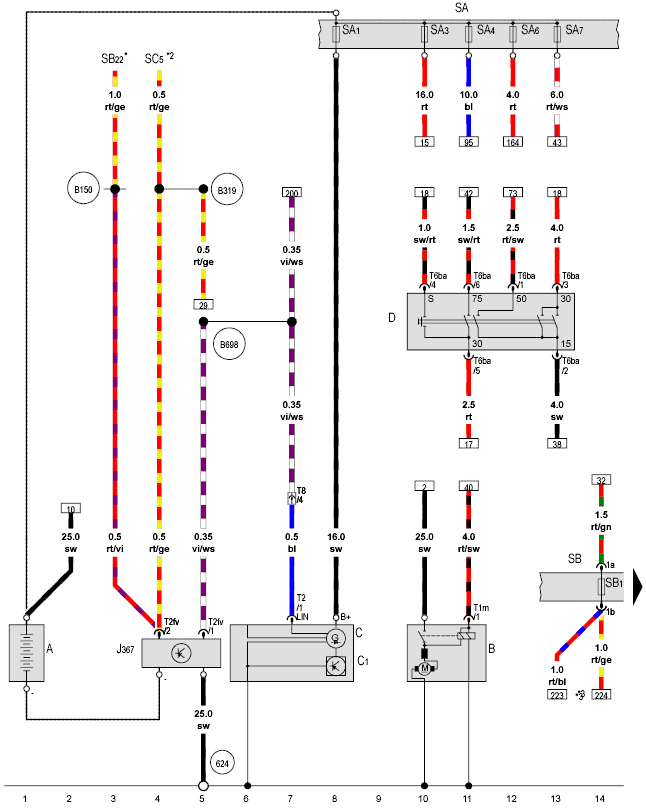
In the above diagram we also see the components B (the starter motor) and D (the ignition lock). This section is highlighted in the following diagram. Above the starter motor (B) we see two wires: a thick black wire (25 mm²) and a, relatively, thinner red/black wire.
At the top of the black wire we see a rectangle with a 2 in it. This is a reference to another part of the schematic. This refers to the horizontal line below the diagram.
All engine compartment diagrams are numbered as follows: under the first diagram the horizontal line starts with 1 and ends at 14. The second diagram starts with 15 and continues until 28. The last diagram ends with 238. If we look at reference 2 , we look for this coordinate on the horizontal line. Coincidentally, the reference is now on the same image. Looking up at number 2 we find a black 25mm² from the positive terminal of the battery to reference 10. This reference goes to number 10 on the horizontal line. If we look up here, we find reference 2 again. This means that these black wires are actually connected together and are actually one wire.
Scheme 2 is a continuation of the previous scheme. The horizontal line now starts at 15. This diagram shows the fuse box (SB) in the dashboard and a relay (J317).
At the top left is a red wire with reference 10. If we follow this reference to the (previous) diagram, we arrive at fuse 3 in fuse holder A. The plus comes from the fuse holder on the battery. This plus connection is connected to various other positive welds (A170, A40 and A32) via the positive weld (B52). The plus splices are connections where several plus wires are connected to each other.
The plus also comes out at relay J317. Terminal 30 of this relay is therefore always powered, regardless of whether the ignition is switched on or off. Terminal 86 is powered via fuse SB20 or SC5, depending on the model year. When this relay is switched on, the voltage is passed via terminal 87 to the fuse holder SB. The fuses SB28 to SB33 are then supplied with voltage. This relay is therefore responsible for the power supply of several components that only receive voltage when the relay is switched on. But which component is responsible for this? We look at reference 60 on terminal 85.
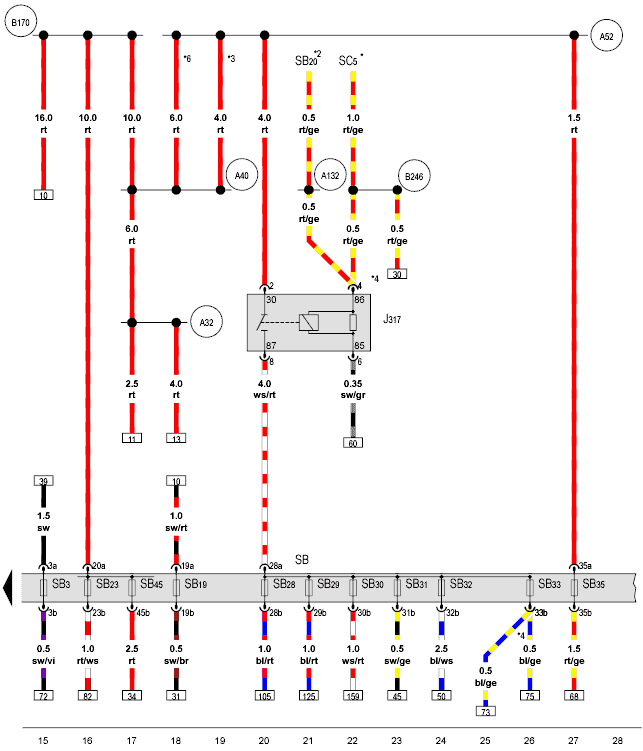
VAG diagrams: plug coding and pin assignment:
In the previous diagram, we looked for the component responsible for turning relay J317 on and off. We looked up the schematic referenced. At number 60 on the horizontal line we look up and come across reference 22. This sw/gr (black/grey) wire from both diagrams is therefore in reality one wire connection. We arrive at control unit J623 (engine control unit). This means that the components supplied with voltage via fuses SB28 to SB33 in the previous diagram are switched on and off indirectly by the engine control unit.
The relevant components associated with this are: the heating element for the lambda sensor, the fuel metering valve, the boost pressure limiting solenoid valve, the EGR cooler changeover valve, the glow plug ECU, the brake light switch and the clutch position sensor. When the ignition is turned off, the relay is not energized and there is no power to these components.
There are a number of plugs on the engine control unit J623. One of these is the T94. This is a 94-pin plug (so 94 possible connections from 1 to 94, not all of which have to be occupied). All wires connected to the ECU in this diagram are connected to connector T94. Each wire has a number, for example /26. This means that this wire is in position 26 of connector T94. We note this as T94/26. If we go with a breakout box to measure, we look for the connection T94/26 in the overview.
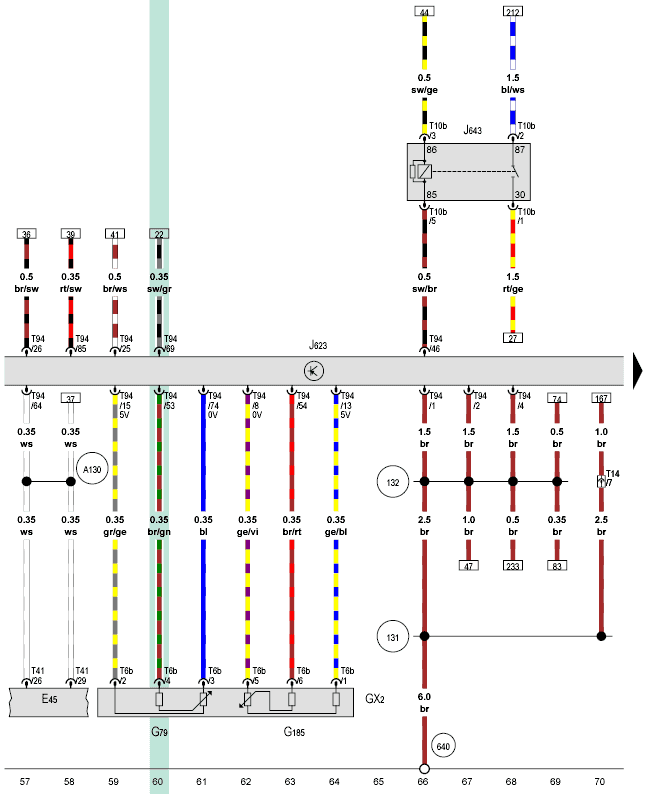
In addition to the connections to the ECU, each component also has its own plug coding and pin assignment. In the previous diagram we look up the component codes G79 and G185. This is the coding of the accelerator pedal sensors. The two sensors are housed in one housing. The housing has a plug with six connections. The coding of the six-pin plug is T6b. The connections are 1 to 6. The most left connection has the code T6b/2. This terminal is connected with a gray/yellow wire to T94/15 on the engine control unit. The function of each wire and terminal is discussed in the next section.
VAG diagrams: plus, ground and signal wires from an active sensor:
The following diagram shows part of the accelerator pedal sensors G79 and G185 from the previous diagram. We see six connections in the housing; three for G79 and three for G185.
Pin 2 of connector T6b is connected to T94/15 on the engine-ECU. Here it is stated: 5V. This is the plus terminal of the active sensor. The blue wire on pin 3 of the sensor is the ground wire (0 volts). The middle one (brown/green) is the signal wire.
The engine-ECU applies a voltage of 5 volts to the accelerator pedal sensor, which is an application of the potentiometer. Depending on the position of the accelerator pedal, the electronics send a voltage to the ECU. The arrow on the resistance (the runner) moves up or down when you press the accelerator pedal.
- Down arrow: signal voltage high.
- Up arrow: signal voltage low.
- The higher the arrow is, the more voltage is absorbed by the resistor before it reaches the runner.
De interface electronics in the ECU translates the height of this signal voltage to the accelerator pedal position. The second sensor is built in for safety. The bishop is reversed here; that means that the signal voltage is inversely proportional: if the voltage at sensor 1 increases, the voltage at sensor 2 will decrease. If this is met, the ECU accepts this signal.
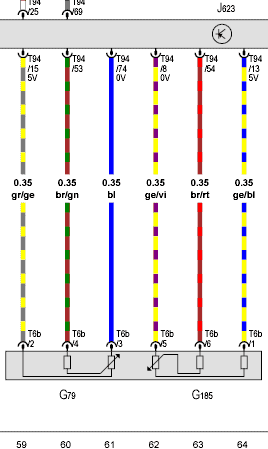
In the following scheme we are again dealing with active sensors. In this case, the sensors do not each have their own power wires, but are distributed. In this diagram we see the following components:
- G247: fuel pressure sensor;
- G581: boost pressure regulator position sensor;
- G40: Hall sensor.
Let's look at the fuel pressure sensor first. On pin 2 of connector T3o, this sensor is connected to T60/40 on the engine control unit by means of a yellow/grey wire. We can assume that this is the signal wire. In addition to this signal wire, the sensor must also be equipped with a plus and ground wire. We are looking at pin 1 of plug T3o. This brown wire joins the brown wires of the other sensors at designation 85. This number can be seen to the left and right of the horizontal connecting line. In the legend this is referred to as "mass weld 1 cable strand engine compartment".
Almost the same applies to the plus wire: the plus wires are marked D141 (plus weld 5v engine compartment).
When we're dealing with a breakdown, we're interested in where the actual plus and ground wires come from. We follow the references.
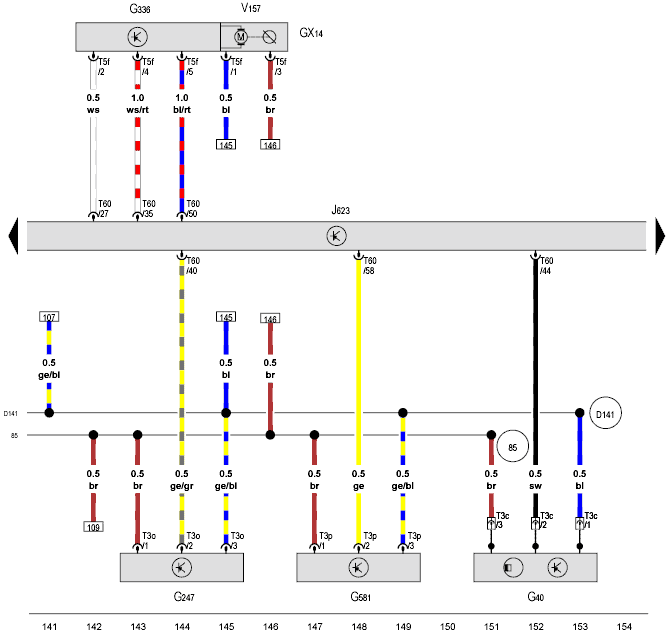
The positive weld (D141) and ground weld (85) are shown in the following diagram. These positive and ground wires come together at the engine-ECU connector terminals T60/10 and T60/51.
Component GX5 is the solenoid valve of the EGR. The G212 and V338 are the position sensor and electric motor of the EGR valve.
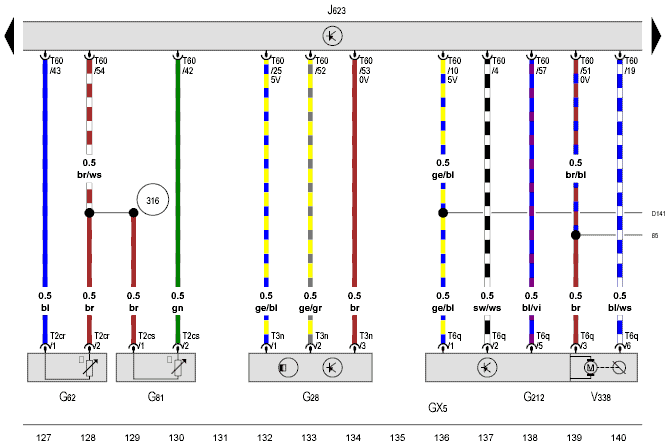
VAG Schematics: Shielded Wires:
A magnetic field can interfere with a sensor signal. In the case of a number of signals, this can have negative consequences on the functioning of the engine. In order to reduce the influence of this interference signal as much as possible, the signal wire is wrapped by a separate wire that is grounded by the ECU by means of filter circuits. Shielded wires are often used in the signal wires of:
- throttle position sensor;
- inductive crankshaft sensor;
- knock sensor.
In the schematic we see that the wires of component G61 (knock sensor) are circled with a broken dashed line. This circle is connected with a black 0,35 mm² to in 38 of the ECU.
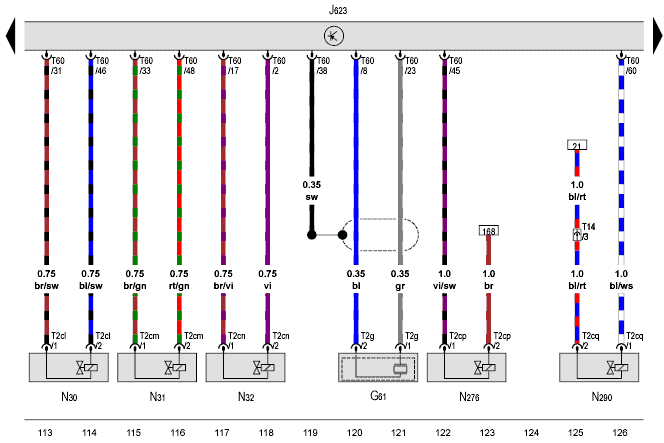
VAG Schemes: Networks:
The following diagram shows a LIN bus network of a master (J519 – electrical installation control unit) and two slaves. The LIN bus is a single-wire communication system. This means that the communication between the various control units is via only one wire.
- G578, G273, G384: sensors alarm system, angle of inclination and interior monitoring. The three sensors are housed in one housing;
- H12: alarm horn.
The master communicates with the slaves via the vi/ws (violet-white) LIN bus wire. In the schematic this wire is indicated by the number: B549.
The supply wires of the sensors run through various references to the plus and ground points in other diagrams. How we can look that up is described in one of the first paragraphs on this page.
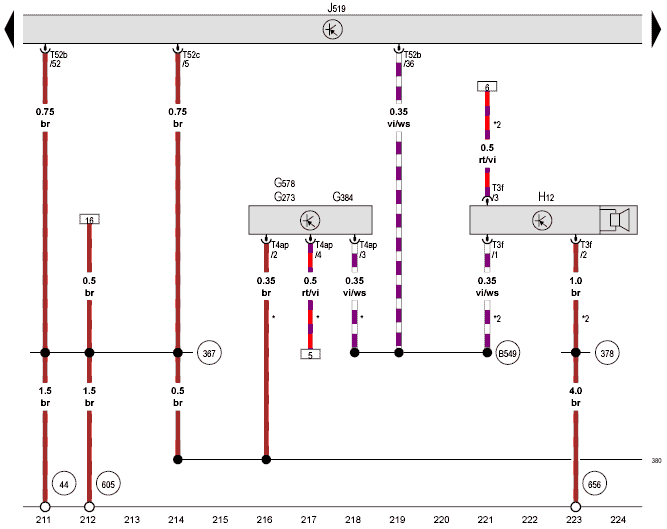
The CAN bus system is shown in the following diagram. Communication is via two wires: CAN-high (B397) and CAN-low (B406).
The control units shown are the:
- J386: driver side door control unit;
- J387: passenger side door control unit;
- J533: gateway.
The door control unit J386 is connected to the other control units in the network via the CAN bus wires. In addition to the CAN bus, a LIN bus wire can also be seen on pin 15 of this control unit. The LIN bus wire is connected to the exterior mirror.
When we want to look up all the control units of this bus system, we look at what the horizontal lines of B397 and B406 are connected to. These lines run through ten other schemes, where on each scheme one or more control units are connected in parallel to these CAN bus wires.
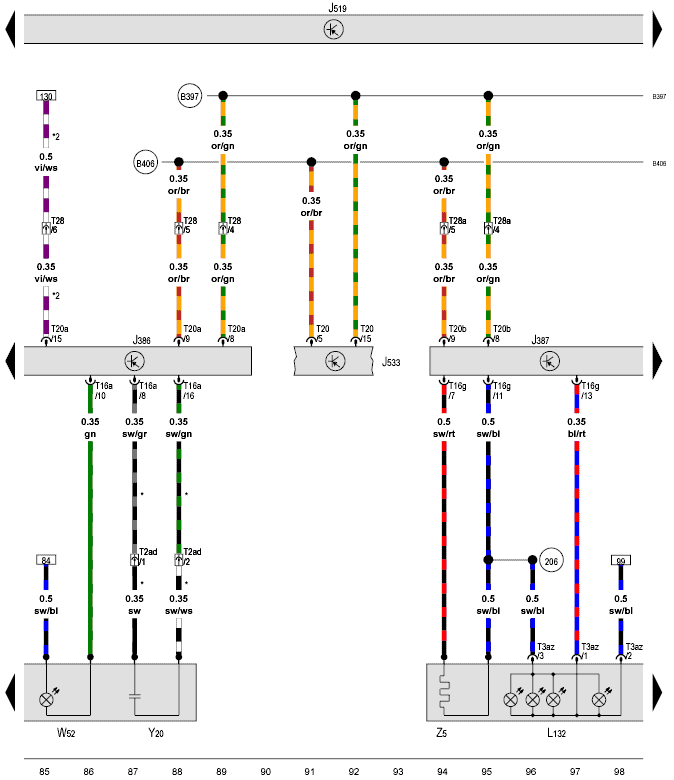
Read VAG Schematics Command:
By reading and understanding the above explanation you will become familiar with the symbols, abbreviations and references of the VAG schemes. The following assignment gives the opportunity to make an exercise with your acquired knowledge. Below you will find an instructive assignment about schema reading that consists of a complete schema of a comfort system, a questionnaire and a sheet with answers. Of course, try to make the questions first before looking at the answers!

HGS data lighting schedule:
The electrical diagram below is from HGS data and is from a BMW. Below the diagram, the legend shows the meanings of the numbers and abbreviations. The top and bottom lines in the diagram are the battery plus and minus. R means: radio mode; this is also called terminal 75. Terminal 15 is shown below: voltage is applied here when the ignition is switched on.
The positive terminals 30, R and 15 are connected to the fuse box P21 with red (rt), green (gn) and purple (li). Four wires run from the fuse box to control unit 08 and to the light sensor (B19).
The steering column switch S21sc is operated by the driver of the vehicle. The position of the switch is passed on to the ECU. Pins 9 and 7 of the switch are connected to pins 12 and 13 of the ECU by a blue and white wire.
In the ECU, the position of the switch is translated into a control of the lighting. Each lamp has its own connection to the ECU. The moment the driver switches on the parking lights, the ECU switches on the power supply of the following lamps: E01, E02, E51, E52, E65, not to mention the dashboard lighting: 58d.
It can also be seen that there is a LIN bus communication between the light module control unit, light sensor and the instrument cluster.
There are several ground points. The locations of these ground connections can be traced back to the legend.
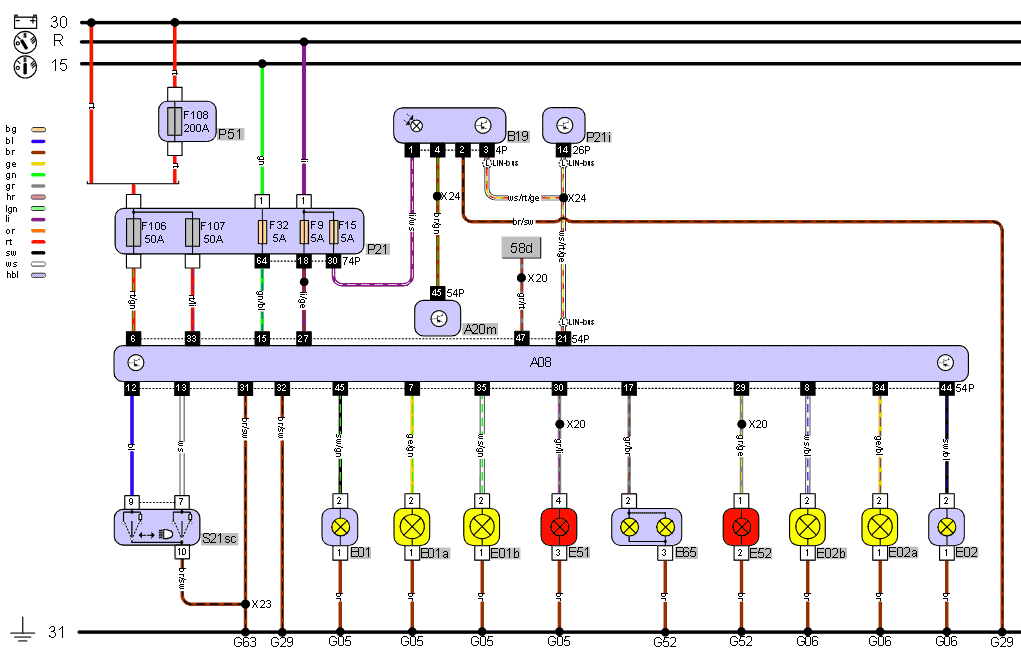
Description:
F108 Maxi fuse 200 A
5A Fuse 5A (3)
15 Ignition on – 15
30 Battery voltage – 30
31 Mass – 31
50A Maxi fuse 50 A (2)
58d Instrument lighting
A08 Light Module
A20m ECU Multifunction Unit
B19 Light sensor
E01 Left parking light bulb
E01a Low beam lamp Left
E01b High beam bulb Left
E02 Right parking light bulb
E02a Dipped beam lamp Right
E02b Bulb high beam Right
E51 Taillight Left
E52 Taillight Right
E65 License Plate Light
G05 Ground at left headlight (4)
G06 Ground at right headlight (3)
G29 Ground to cardan tunnel (2)
G52 Luggage compartment mass R (2)
G63 Mass under driver's seat
L LIN bus (3)
P21 Fuse Box Interior
P21i Combi Instrument
P51 Main fuse box Luggage compartment
R Radio position – R
S21sc Steering column switch
X20 Steering column connection (3)
X23 Connection behind left dashboard
X24 Connection behind dashboard right (2)
HGS data wiper schedule:
The diagram below shows the wiper installation of a Smart. The wiper motors are switched on and off via the relay. The relay K09r is from the rear wiper motor and is connected to ground by the control unit. The switch is not in direct communication with the relay; the control unit turns on the relay when:
- the switch in position 1 (interval) position 2 (constant speed) or position 3 (high speed);
- when controlling with diagnostic equipment, for example during an actuator test .
On the rear wiper motor, the black/red wire on pin C is the plus wire; this connection is connected to terminal 17 of the ignition lock via the fuse (F15). When the ignition is switched on, there is always voltage on pin C.
The brown wire is the ground wire; this wire is connected to the ground point G55, on the left in the trunk, via connection X51 in the tailgate.
A green/blue wire is connected to pin B, which goes to terminal 87 (not visible in the diagram) of the relay (connection 1). The main power is turned on and off at this point.
When the wiper switch S27W is turned on, the ECU connects terminal 85 of relay K09r (control current output) to ground. The relay is energized at that time. Less than a second later, the control stops. The wiper motor completes its movement thanks to the contact plate. It remains in the zero position until the relay is actuated for another second. We call this the interval. There is a small pause between each back-and-forth movement of the wiper arm. The time between the actuations can often be set on the wiper lever.
The switches in the wiper motor are in reality the conductive contact plate and the sliding contacts.
The front wiper motor (M11) works in a similar way. Connection B is the ground connection, A position 1 (low position and interval), E position 2 (high speed) and D to allow the motor to move back to the zero position by means of the conductive contact disc.
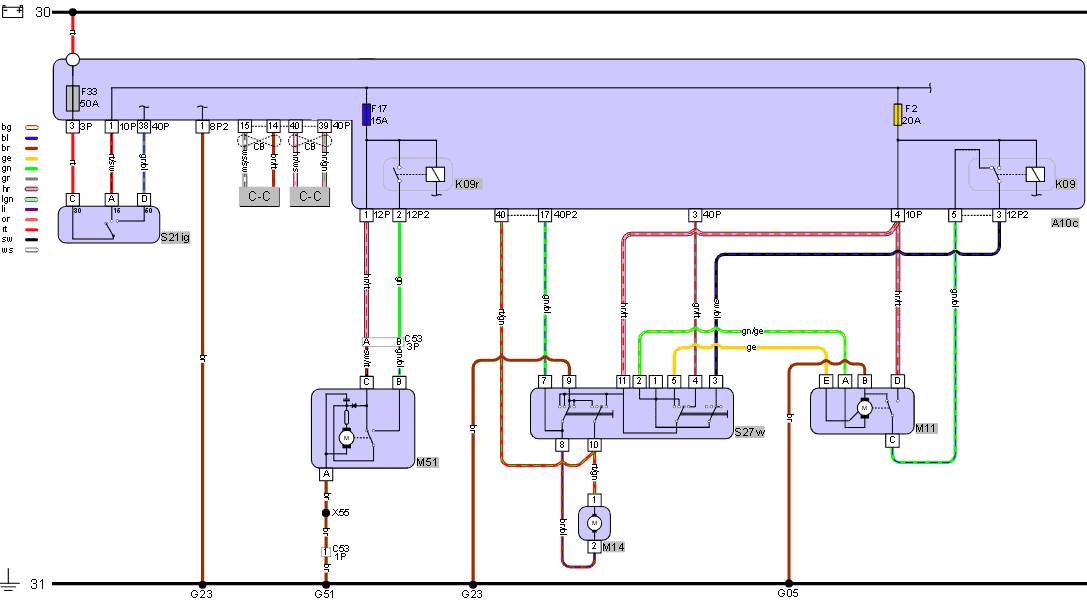
Description:
#1 Resistance
#2 Diode
15A Fuse 15A
20A Fuse 20A
30 Battery voltage – 30
31 Mass – 31
50A Maxi fuse 50 A
A10c Central electrical installation interior
CC CAN bus comfort (2)
C53 Left D-pillar connector (2)
CB CAN bus (2)
G05 Ground at left headlight
G23 Ground behind dashboard L (2)
G51 Mass luggage space L
K09 Windshield Wiper Motor Relay
K09r Relay rear wiper motor
M11 Windshield Wiper Motor
M14 Windshield Washer Pump
M51 Rear wiper motor
S21ig Ignition/Start Switch
S27w Wiper/windscreen washer switch
X55 Tailgate connection
